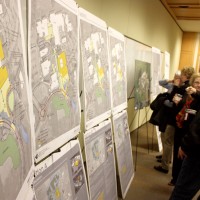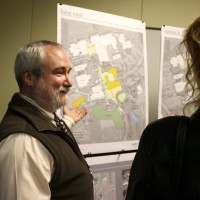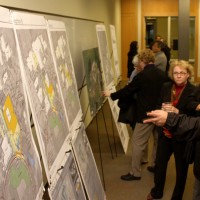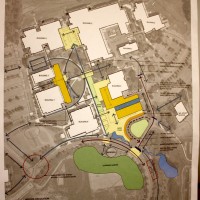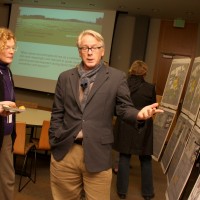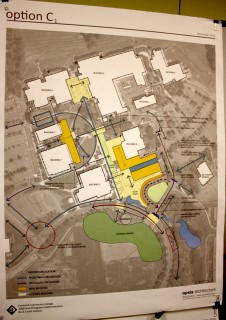This content was published: December 7, 2010. Phone numbers, email addresses, and other information may have changed.
A plan takes shape for Rock Creek
Photos and story by James Hill
Portland Community College’s Rock Creek Campus in Washington County has decided on a general layout for its first phase of bond construction.
A steering committee of staff and community members chose the Option C out of four possible plans. The option attaches a two-story addition to the east side of Building 7 and builds a combination of two and three-story structures to Building 5. The option was one of the least expensive of the plans considered because it efficiently taps into the surplus capacity and current infrastructure of the buildings.
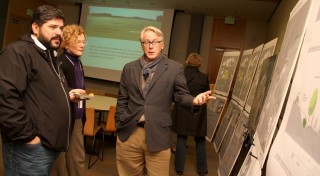
James Meyer (right) of Opsis discusses the Rock Creek bond plans with Barbara Linn (bond project manager for Rock Creek) and a college staffer.
Rock Creek Campus President David Rule said the campus planners and the Rock Creek architect – Opsis Architecture & Engineering – will start thinking about the design of the new buildings. The first task for construction will be to work on the facade of Building 7, bordering the quad, he said.
“First, we have to rough out where the programs will go and then we can move forward,” Rule said. “The goal is to get some consideration of what the construction will be and start it during the summer season when it’s least disruptive.“
In addition, plans include completing a second access road to Rock Creek on 185th Avenue. The new road would be used for emergency vehicle access as well as for campus evacuations in school emergencies.
“Washington County wants us to have another way off this campus,” Rule said. “Everybody is behind having this emergency road and when 185th gets upgraded we’ll be ready to go in making it a second entrance. It should be a very scenic entrance when it’s put to full use.”
A year’s worth of campus and community engagement activities following the passage of PCC’s $374 million bond measure in 2008, led to four potential campus designs. Each one would have added at least one building and provide a second entrance.
Opsis, PCC bond staff and college leadership have hosted open houses for the community to view and give input on the campus designs, to propose hybrids or alternate options, and discuss critical issues such as building placement, parking and second exit.
The decision came as a result of the formation of communities of interest, in which groups focused on specific areas that the bond would impact. These areas of interest include learning, health and wellness, infrastructure and sustainability. To convey future wishes, staff hosted interactive displays where people passing by could rearrange miniature buildings on a campus map in addition to the plethora of meetings and surveys involving the community.
“We joked we had meetings with every kind of table possible,” said James Meyer, principle architect with Opsis. “We had everybody involved across the campus in terms of faculty, students and staff. There was a lot of information taken and recorded and made available.”
A key point to the future design will be a better front doorstep of sorts for the campus. Comments from the community illustrated a lack of a welcome point for people coming onto Rock Creek.
“You don’t end up with a ‘there there’ when you arrive onto the campus,” Meyer said of the lack of a front door to the rural campus. “We want the way-finding comfortable and an understanding of where you want to go and where you should go.”
For more information about the bond, visit: pcc.edu/about/bond

